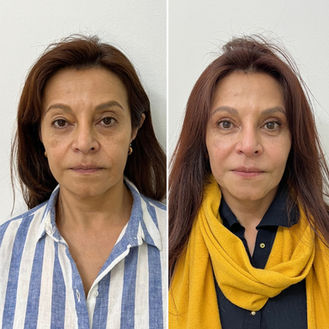Blepharoplasty
What is blepharoplasty?
The eye area is often one of the first regions of the face to show visible signs of aging. Under-eye bags and drooping upper eyelids that develop over time can be addressed through cosmetic eyelid surgery, known as blepharoplasty.
Blepharoplasty is a procedure designed to rejuvenate tired or heavy-looking eyes by removing excess skin and fat from the upper and/or lower eyelids. It may also be performed in combination with other treatments such as brow lift surgery, facelifts, dermal fillers, laser resurfacing, or chemical peels to enhance overall facial harmony.

Who are the candidates for this surgery?
Ideal candidates are healthy individuals seeking results that enhance their natural features without altering the unique expression of their eyes. While blepharoplasty is commonly performed in patients between the ages of 30 and 35, it can also be indicated at a younger age in cases where genetic factors contribute to early eyelid aging.
What is the surgery like?
The procedure takes approximately two hours and is performed in a fully equipped operating room at a reputable hospital. For the patient’s comfort, either general anesthesia or sedation is administered. It is an outpatient procedure, allowing the patient to return home just a few hours after surgery to begin recovery.
The procedure is generally not painful—most patients experience only mild discomfort, which is temporary and manageable when post-operative instructions are followed properly.
This procedure typically causes mild to moderate localized swelling. Bruising is common during the first few days, and its intensity varies depending on the individual and the extent of the procedure. You will be advised to sleep with your head elevated on two or three pillows for the first 48 hours to help reduce swelling. Showering is allowed the next day, as usual.
The use of anti-inflammatory and healing balms is recommended to support the recovery process.
Eyelid scars are virtually imperceptible. While they may be noticeable at first, they gradually fade over time and become increasingly difficult to detect.
What can I expect after surgery?
What is necessary for surgery?
A full preoperative evaluation is essential. This typically includes comprehensive blood work, an electrocardiogram reviewed by a cardiologist, a chest X-ray, and an ophthalmologic assessment in cases where the patient has a relevant medical history that could impact the surgery.
A thorough medical consultation, an accurate diagnosis, and the evaluation of different blepharoplasty techniques are key to understanding each patient’s goals and achieving the best possible outcome.
When can I return to my daily activities?
Strenuous physical activity should be avoided during the first week. However, most patients are able to return to work within that time. If you have a major social or professional event, it is advisable to schedule surgery at least 3 to 4 weeks in advance to allow sufficient time for recovery and visible healing.









